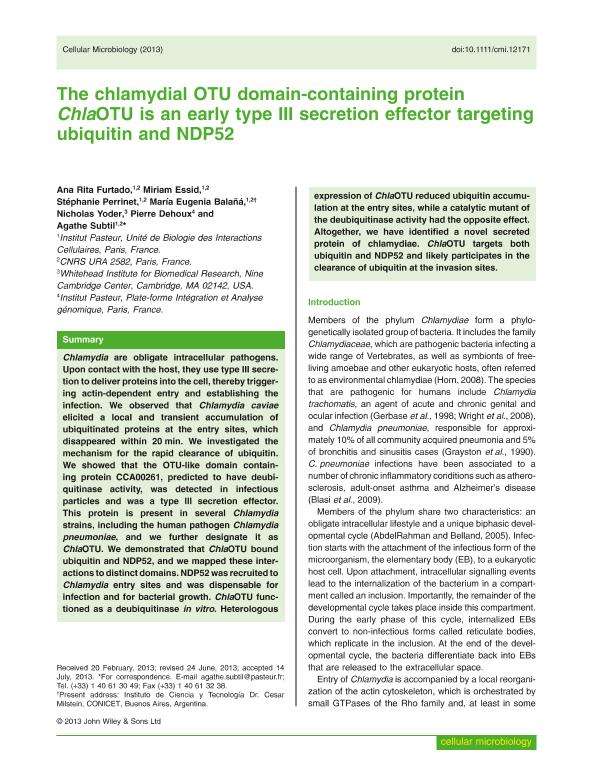Artículo
The chlamydial OTU domain-containing protein ChlaOTU is an early type III secretion effector targeting ubiquitin and NDP52
Furtado, Ana Rita; Essid, Miriam; Perrinet, Stéphenie; Balaña, Maria Eugenia ; Yoder, Nicholas; Dehoux, Pierre; Subtil, Agathe
; Yoder, Nicholas; Dehoux, Pierre; Subtil, Agathe
 ; Yoder, Nicholas; Dehoux, Pierre; Subtil, Agathe
; Yoder, Nicholas; Dehoux, Pierre; Subtil, Agathe
Fecha de publicación:
08/2013
Editorial:
Wiley
Revista:
Cellular Microbiology (print)
ISSN:
1462-5814
Idioma:
Inglés
Tipo de recurso:
Artículo publicado
Clasificación temática:
Resumen
Chlamydia are obligate intracellular pathogens. Upon contact with the host, they use type III secretion to deliver proteins into the cell, thereby triggering actin-dependent entry and establishing the infection. We observed that Chlamydia caviae elicited a local and transient accumulation of ubiquitinated proteins at the entry sites, which disappeared within 20 min. We investigated the mechanism for the rapid clearance of ubiquitin. We showed that the OTU-like domain containing protein CCA00261, predicted to have deubiquitinase activity, was detected in infectious particles and was a type III secretion effector. This protein is present in several Chlamydia strains, including the human pathogen Chlamydia pneumoniae, and we further designate it as ChlaOTU. We demonstrated that ChlaOTU bound ubiquitin and NDP52, and we mapped these interactions to distinct domains. NDP52 was recruited to Chlamydia entry sites and was dispensable for infection and for bacterial growth. ChlaOTU functioned as a deubiquitinase in vitro. Heterologousexpression of ChlaOTU reduced ubiquitin accumulation at the entry sites, while a catalytic mutant of the deubiquitinase activity had the opposite effect. Altogether, we have identified a novel secreted protein of chlamydiae. ChlaOTU targets both ubiquitin and NDP52 and likely participates in the clearance of ubiquitin at the invasion sites.
Palabras clave:
Chlamydia
,
Ubiquitin
,
Invasion Sites
Archivos asociados
Licencia
Identificadores
Colecciones
Articulos(ICT - MILSTEIN)
Articulos de INST.DE CS. Y TECNOLOGIA "DR. CESAR MILSTEIN"
Articulos de INST.DE CS. Y TECNOLOGIA "DR. CESAR MILSTEIN"
Citación
Furtado, Ana Rita; Essid, Miriam; Perrinet, Stéphenie; Balaña, Maria Eugenia; Yoder, Nicholas; et al.; The chlamydial OTU domain-containing protein ChlaOTU is an early type III secretion effector targeting ubiquitin and NDP52; Wiley; Cellular Microbiology (print); 15; 12; 8-2013; 2064–2079
Compartir
Altmétricas



